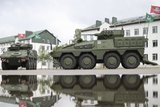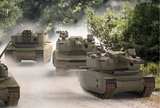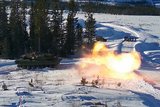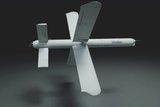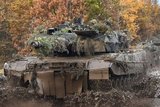Northrop Grumman demonstrates SiVAN
Northrop Grumman has successfully demonstrated advanced technologies for ground vehicle protection and situational awareness at the Camp Roberts range with its Smart Integrated Vehicle Area Network (SiVAN) and vehicle-mounted sensors, according to a company statement on 25 October,
In one of the test scenarios, Northrop Grumman simulated a typical convoy mission leaving a Forward Operating Base. By using SiVAN and vehicle-mounted sensors, crews in multiple vehicles ‘maintained situational awareness with each other and the Tactical Operations Center (TOC) under all weather conditions’. Being connected to a wireless mesh network, the systems ‘shared target information with other networked sensors and with the TOC. Operators were able to view imagery from several sensors’.
According to the company, SiVAN is a highly survivable, self-healing vehicle network that uses a simple plug-and-play interface to connect disparate technologies and allows warfighters to add devices as needed and distribute the data throughout the network. It provides a self-forming information link between devices, local area dismounts, unmanned aerial vehicles and any other platform, allowing them all to interoperate seamlessly. The network's open architecture foundation is optimized for the rapid integration of future technologies.
Kay Burch, vice president of communications, intelligence & networking solutions for Northrop Grumman's Land and Self Protection Systems Division, said the test had important implications for the safety of military convoys, resupply and force mobility in theatre, all of which face a ‘number of significant threats’.
‘Improving their safety was one of the goals of our testing at Camp Roberts. The digital interoperability we demonstrated here will improve warfighters' situational awareness by giving them greater access to the information they need, when they need it,’ Burch said.
Other systems integrated and tested during the exercise included fire control systems, targeting systems, radars, unattended ground sensors, acoustic sensors and survivability equipment. Northrop Grumman's Rotorcraft Avionics Innovation Laboratory performed the rapid integrations.
More from Land Warfare
-
Germany signs multi-billion-dollar deals for 6x6 CAVS and GDELS Eagle vehicles
The order is a further boost for the Common Armoured Vehicles System programme which has notched notable successes in the past 12 months. The first vehicle, made in Finland, will be delivered next year with local production expected to ramp up in 2027.
-
![Rheinmetall and KNDS tank tie-up narrows trans-European options]()
Rheinmetall and KNDS tank tie-up narrows trans-European options
The French and German governments signed an agreement in June 2018 to cooperate on the development of a new main battle tank under the Main Ground Combat System programme but the effort has struggled. This new agreement may damage it further.
-
![2025 land market review: British Army woes, European heavy armour and US MBT progress]()
2025 land market review: British Army woes, European heavy armour and US MBT progress
The last year has seen several major procurements in the land market. Shephard’s Dr Peter Magill reviews the main trends and themes in land procurement of 2025.
-
![Hungary set to begin using Hero 400 loitering munitions]()
Hungary set to begin using Hero 400 loitering munitions
Developed by Israel's Uvision and with systems being sold in the thousands to multiple European NATO countries and the US, the Hero family of loitering systems is also in production in the US and Italy, the latter through Rheinmetall.
-
![Croatia orders Leopards and CAESAR howitzers as Lithuania orders more CAESARs]()
Croatia orders Leopards and CAESAR howitzers as Lithuania orders more CAESARs
The Leopard is becoming the tank of choice in central and eastern Europe as Croatia joins Lithuania, the Czech Republic and Hungary in ordering the platform. Lithuania and Croatia have also signed for CAESAR howitzers.













